Coat of arms of Ukraine
The coat of arms of Ukraine is a blue shield with a gold trident. Officially referred to as the Emblem of the Royal State of Volodymyr the Great,[1] or, colloquially, the tryzub (Ukrainian: тризуб), the insignia derives from the seal-trident of Volodymyr the Great, the first Grand Prince of Kyiv.
| Coat of arms of Ukraine | |
|---|---|
 | |
| Versions | |
 The banner of arms, which serves as presidential standard | |
| Armiger | Ukraine |
| Adopted | 19 February 1992 |
| Blazon | Azure, a tryzub Or |
| Earlier version(s) |  .svg.png.webp) |
| Use | Ukrainian People's Republic (1918–1920) |
The small coat of arms was officially adopted on 19 February 1992, while constitutional provisions exist for establishing the great coat of arms, which is not yet officially adopted. The small coat of arms was designed by Andriy Grechylo, Oleksii Kokhan, and Ivan Turetskyi. It appears on the Presidential Standard of Ukraine. Blue-coloured tridents are considered to be an irregular representation by the Ukrainian Heraldry Society. The greater coat of arms which has not been adopted consists of the small coat of arms and the coat of arms of Zaporizhian Host (Constitution of Ukraine, Article 20).
The trident was not thought of as a national symbol until 1917, when one of the most prominent Ukrainian historians, Mykhailo Hrushevskyi, proposed to adopt it as a national symbol (alongside other variants, including an arbalest, a bow or a cossack carrying a musket, i.e. images that carried considerable historical and cultural and heraldic significance for Ukraine). On 25 February 1918, the Central Rada (parliament) adopted it as the coat of arms of the short-lived Ukrainian People's Republic.
During the Soviet period of 1919–1991 and independence between 1991 and 1992, the state symbols were consistent with the Russian SFSR and the Soviet Union – a hammer and sickle over the rising sun.
Tryzub
The modern "trident" symbol was adopted as the coat of arms of the Ukrainian People's Republic in February 1918. The design has precedents in seals of the Kyivan Rus. The first known archaeological and historical evidence of this symbol can be found on the seals of the Rurik dynasty. However, according to Pritsak, the stylized trident tamga, or seal which was used by Rus rulers such as Sviatoslav I of Kiev and similar tamgas that were found in ruins are Khazar in origin.[2][3][4]
It was stamped on the gold and silver coins issued by Prince Volodymyr the Great (980–1015), who might have inherited the symbol from his ancestors (such as Svyatoslav I Igorevich) as a dynastic coat of arms, and he passed it on to his sons, Svyatopolk I (1015–19) and Yaroslav the Wise (1019–54). The symbol was also found on the bricks of the Church of the Tithes in Kyiv, the tiles of the Dormition Cathedral in Volodymyr, and the stones of other churches, castles, and palaces. There are many examples of it used on ceramics, weapons, rings, medallions, seals, and manuscripts.
.svg.png.webp) The seal of Sviatoslav the Brave (945)
The seal of Sviatoslav the Brave (945).svg.png.webp) Coin of Volodymyr the Great (980)
Coin of Volodymyr the Great (980).svg.png.webp) Coin of Yaroslav the Wise (1019)
Coin of Yaroslav the Wise (1019) The coat of arms of the Ukrainian People's Republic (1918)
The coat of arms of the Ukrainian People's Republic (1918)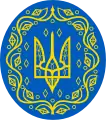 The Greater coat of arms of the Ukrainian People's Republic, (1918)
The Greater coat of arms of the Ukrainian People's Republic, (1918)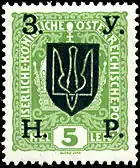 The Ukrainian trident overprint of May 1919 on a five-heller stamp of Austria-Hungary
The Ukrainian trident overprint of May 1919 on a five-heller stamp of Austria-Hungary

Most historians agree that the medieval symbol was not intended as depicting a trident, but rather, was a symbol of the Holy Trinity;[5] it also was most likely a stylized falcon. Depictions of a flying falcon with a Christian cross above its head have been found in Old Ladoga, the first seat of the Kievan Rurik dynasty,[6] of Scandinavian lineage.[7] Such a falcon, along with a cross are also featured on the coins of Olaf Guthfrithsson, a Viking king of Dublin and Northumbria.[6]
Falconry has been a royal sport in Europe for centuries. The gyrfalcon (known also as Norwegian falcon) was considered a royal bird and is mentioned (ukr.: рарог) in one of the earliest epics of Ruthenia, the 12th century poem The Tale of Ihor's Campaign.
Later images of the trident ("tryzub") among the Rurikids resemble more a bident or the letter "У", which also in the modern Cyrillic alphabet denotes the sound "u" as in "Ukraine" (though the Cyrillic alphabet at the time did not use this letter individually, using the digraph ОѴ/оу or its monogram Ꙋ instead).
- Dimensioning of the coat of arms


Other uses
The Tryzub is heavily used in the military heraldry to commemorate the participation on the Eastern Front during World War II. At least 36 units of the Italian Army carry the Tryzub in their Coat of Arms, as they were awarded a Medal for Military Valor during their service on the territory of Ukraine. The Tryzyb is the Coat of arms of Zaslawye. Worth noting is that the Tryzub was also used in conjunction with the Russian tricolour, as the symbol of the anti-communist movement National Alliance of Russian Solidarists in the early 20th century.
Historical coats of arms
Kingdom of Ruthenia
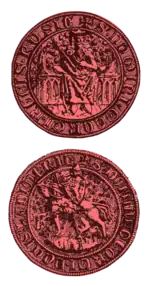

The coat of arms for the Kingdom of Ruthenia (Latin: Regnum Russiæ) and Duchy of Galicia–Volhynia has existed since the 12th century. It consisted of a lion on an azure heater shield.[10] The Ruthenian lion first appears in the seal of the Ruthenian king Yurii I, dated to the beginning of the XIV century. There is an image of a monarch on a throne, and on the reverse, an armed horseman holding a shield with a lion on his hind leg, an example of equestrian seals common in Europe at the time. On the seal, there is an inscription in Latin: "Sigillum Domini Georgi Regis Rusie" (Seal of the owner of George-Yuri, King of Ruthenia), on the back: "Sigillum Domini Georgi Ducis Ladimerie" (seal of the owner of George-Yuri, prince of Lodomeria).
On the seal of his son Lev II, only a lion without a rider is depicted. The animal stands on its hind legs and reverses to the left.
Figures of lions as symbols of Ruthenia are found on the silver coins of the Lithuanian prince Lubart, the last ruler of the Kingdom of Ruthenia (1340–1383), and his son Fedor (1384–1387). We see the same motive on Ruthenian money, the issue of which continued during the reign in Ruthenia of the Polish king Casimir III (1349–1370), the Hungarian king Louis (1370–1372, 1378–1382) and his governor, Prince of Opolsk Vladislav (1372–1378).
After the occupation of Eastern Galicia by the Kingdom of Poland as a result of the Galicia–Volhynia Wars, the coat of arms with many changes was adopted as part of the Ruthenian Voivodeship (Latin: Palatinatus russiae, Ruthenian Palatine). It was abandoned with partition of Poland and annexation of territory by the Austrian Empire. At the end of World War I and dissolution of Austria-Hungary, the Western Ukrainian People's Republic revived the coat of arms. With the annexation of the West Ukraine by Poland again in 1918 and later the Soviet Union, the gold lion symbol became the coat of arms for the city of Lviv.
| Kingdom of Ruthenia | |||
|---|---|---|---|
 |
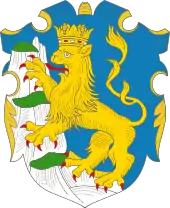 |
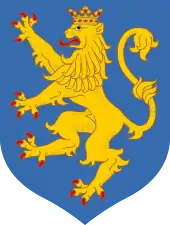 | |
| Coat of arms of the Kingdom of Rus | Coat of arms of the Ruthenian Voivodeship | Coat of arms of the West Ukrainian People's Republic | |
Cossack Hetmanate (Cossack with musket)
A Cossack with a musket was an emblem of the Zaporizhian Host and later the state emblem of the Hetmanate and the Ukrainian State. The origin of the emblem is uncertain, while its first records date back to 1592. On the initiative of Pyotr Rumyantsev, the emblem was phased out and replaced by the Russian double-headed eagle in 1767.
A Cossack with a rifle was restored by the Hetman of Ukraine Pavlo Skoropadsky in 1918. The emblem disappeared until in 2005, when it reappeared on the proposed Great Seal of Ukraine.
| Cossack Hetmanate, Zaporizhia and Ukrainian State | |||
|---|---|---|---|
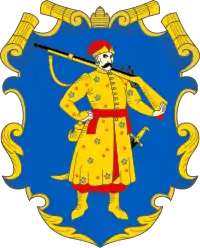 |
.svg.png.webp) |
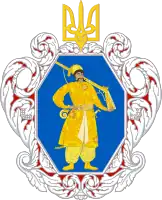 | |
| Coat of arms of the Zaporizhian Host (Cossack Hetmanate) | Coat of arms of the Zaporizhian Host the Lower (Zaporizhian Cossacks) | Coat of arms of the Ukrainian State in 1918 (did not have time to approve, because the hetman renounced power) | |
Grand Duchy of Ruthenia (Archistrategos Mykhaïl)
The importance of the Kyiv region coat of arms with Archangel Michael known as Archistrategos Mykhaïl arose during discussion of the so-called 1658 Hadiach Treaty between the delegation of the Cossack Hetmanate and the Crown of Poland, that foresaw the transformation of the Commonwealth into the Polish–Lithuanian–Ruthenian Commonwealth.
| Ruthenia, Polish–Lithuanian Commonwealth, Cossack Hetmanate, Russian Empire, Ukraine | ||||
|---|---|---|---|---|
 |
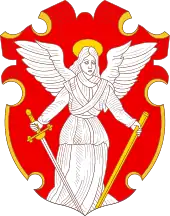 |
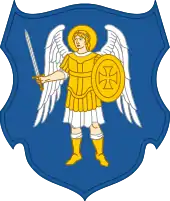 |
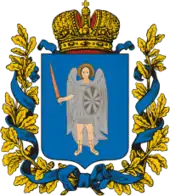 |
 |
| Coat of arms of Kyiv Land | Coat of arms of Kijów Voivodeship | Coat of arms of Kyiv Regiment | Coat of arms of Kiev Governorate | Coat of arms of Kyiv City |
| Proposed / Drafts | ||||
|---|---|---|---|---|
 |
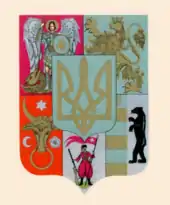 |
|||
| Coat of arms of the January Uprising | Bytynskyi coat of arms of Ukraine | Kokhan coat of arms of Ukraine[11] | ||
Carpathian Ruthenia (Red bear)
The coat of arms was created after the end of the First World War, when Carpathian Ruthenia (then called Subcarpathian Rus') was transferred from Hungary to the newly created state of Czechoslovakia. It was designed in 1920 by Czech historian Gustav Friedrich. The Ruthenians had been promised autonomy within the new country, and therefore a coat of arms was created for their land.
| Carpathian Ruthenia | |||
|---|---|---|---|
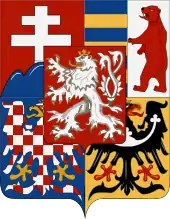 |
 |
 | |
| Middle coat of arms of Czechoslovakia | Coat of arms of Carpatho-Ukraine | Coat of arms of the current Zakarpattia Oblast | |
The coat of arms shows the Ukrainian tinctures (heraldic colours) of blue and gold in its first (dexter) field and a red bear on silver in its second field. The bear is perhaps a symbol of Carpathian wildlife. The horizontal lines (in heraldry called bars) could perhaps have been inspired by the partitions per fess in the coat of arms of Hungary, to which the territory had belonged.
The arms were also used by the short-lived state of Carpatho-Ukraine in 1939, but with the addition of the Ukrainian Tryzub in the uppermost blue field, used previously by the Ukrainian People's Republic. Since the territory is the same for the current Zakarpattia Oblast, the oblast uses the arms as its own minus the trident.
Ukrainian Soviet Socialist Republic
The coat of arms of the Ukrainian Soviet Socialist Republic was adopted on 14 March 1919, by the government of the Ukrainian Soviet Socialist Republic and subsequently modified on 7 November 1928, 30 January 1937, and 21 November 1949. The coat of arms of 1949 is based on the coat of arms of the Soviet Union and features the hammer and sickle, the red star, a sunrise and ears of wheat on its outer rims. The rising sun stands for the future of the Soviet Ukrainian nation, the star as well as the hammer and sickle for the victory of communism and the "worldwide socialist community of states". The banner bears the Soviet Union state motto ("Workers of the world, unite!") in both the Ukrainian and Russian languages. The name of the Ukrainian SSR is shown only in Ukrainian.
After independence on 24 August 1991, Ukraine retained the Soviet emblem. The next year, in 1992, the emblem was changed to the present coat of arms of Ukraine, the tryzub (trident) coat of arms.
| Emblem of the Ukrainian Soviet Socialist Republic | |||
|---|---|---|---|
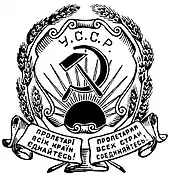 |
_(black_version).jpg.webp) |
.svg.png.webp) |
 |
| 1919–1929 | 1929–1937 | 1937–1949 | 1949–1992 |
Other variations
Among other notable features are Archistratege Michael the Archangel, Pohoń Ruśka (Ruthenian Pursuer), Three crowns (representing three kings Daniel, Leo and George),[10] Galician jackdaw, Volhynian silver cross pattée at the red field, Podolian gold sun, Chernihiv black eagle, Kharkiv crossed cornucopia and caduceus at the green field.
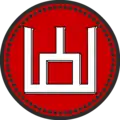 Columns of Gediminas
Columns of Gediminas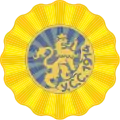 Sich Riflemen emblem on the cockade
Sich Riflemen emblem on the cockade Tryzub of Robert Lisovskyi
Tryzub of Robert Lisovskyi 14th Waffen Grenadier Division of the SS (1st Ukrainian) with a lion and three crowns
14th Waffen Grenadier Division of the SS (1st Ukrainian) with a lion and three crowns City of Lviv in the Soviet Union (1967–1990)
City of Lviv in the Soviet Union (1967–1990)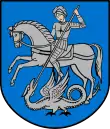 Variation of Pogon Ruska for the city of Kamianets-Podilskyi in (1374–1796) until occupation of Podolia by Russian Empire
Variation of Pogon Ruska for the city of Kamianets-Podilskyi in (1374–1796) until occupation of Podolia by Russian Empire Variation of Pogon Ruska for the city of Nizhyn
Variation of Pogon Ruska for the city of Nizhyn Proposed coat of arms for the Polish–Lithuanian–Ruthenian Commonwealth during the January Uprising
Proposed coat of arms for the Polish–Lithuanian–Ruthenian Commonwealth during the January Uprising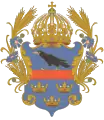 Variation of Galician jackdaw with three crowns
Variation of Galician jackdaw with three crowns
Greater coat of arms
 Mykola Bytynskyi's proposal
Mykola Bytynskyi's proposal Mykola Bytynskyi's proposal
Mykola Bytynskyi's proposal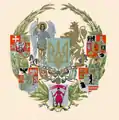 Mykola Bytynskyi's proposal
Mykola Bytynskyi's proposal Mykhailo Hrushevskyi's proposal
Mykhailo Hrushevskyi's proposal.png.webp) 2007 proposal
2007 proposal
In 1917, President of the Central Rada Mykhailo Hrushevsky proposed the Great Coat of Arms in the form of a single shield topped by a dove with olive branch. The shield was split five ways. At its center there was a smaller shield depicting a plough as a symbol of productive peaceful work surrounded by ancient state symbols of Ukraine: the princely arms of Volodymyr the Great (tryzub), Litvin Pogon with a golden lion, cossack with musket, the crossbow of Kyiv and the lion of Lviv.
In the current Constitution of Ukraine there is a constitutional provisions for the establishment of a Great Coat of Arms of Ukraine,[12] although it was never officially adopted[13] and was published in various heraldic sources. In this variant, the shield is supported by a lion from the Galician Coat of Arms on the left and a cossack in traditional dress, wielding a musket, the symbol of the Cossack Hetmanate on the right. The Coat of Arms is crowned with the crown of Volodymyr the Great, symbolizing Ukrainian sovereignty and decorated with viburnum and wheat at the bottom. The official adoption of the Great Coat of Arms has to be endorsed by a two-thirds majority vote (300 votes) in the Verkhovna Rada, the Ukrainian parliament.[13]
Since Ukrainian independence in 1991 four attempts by the Ukrainian government to create an official Great Coat of Arms have failed.[13] On 25 August 2020 the Verkhovna Rada instructed the Shmyhal Government to get an official Great Coat of Arms of Ukraine adopted in time for the 30th Independence Day of Ukraine celebrations on 24 August 2021.[13]
See also
- Armorial of Ukraine
- National symbols of Ukraine
- Symbols of the Rurikids
- Columns of Gediminas
- Cossack with musket
- Flag of Ukraine
- Trishula, Trident of Poseidon
References
- Wolczuk, Kataryna (2001-12-01). The Moulding of Ukraine: The Constitutional Politics of State Formation. Central European University Press. ISBN 978-615-5211-64-5.
- Brook 154
- Franklin & Shepard 120–21
- Pritsak, Weights 78–79.
- Kennedy, Peter; Kassimeris, Christos (22 March 2016). Exploring the Cultural, Ideological and Economic Legacies of Euro 2012. Routledge. p. 23. ISBN 9781317602149.
- Coat of arms of Rurik found in Ladoga. (in Russian)
- Rurik (Norse leader) Britannica Online Encyclopedia
- "Orange Revolution serves as a model for public school students in the South Bronx". The Ukrainian Weekly. September 4, 2005. Archived from the original on December 1, 2008. Retrieved June 26, 2022.
- Tadeusz Olszański, Svoboda party – the new phenomenon on the Ukrainian right-wing scene Archived April 1, 2012, at the Wayback Machine, Centre for Eastern Studies (July 5, 2011)
- History of Galician coat of arms: jackdaw, lion or something totally different (Історія галицького герба: галка, лев, чи щось кардинально інше?). Spravzhnia Varta. 11 June 2019
- "Choice for great state emblem of Ukraine draws criticism".
- Constitution of Ukraine, Article 20.
- (in Ukrainian) The government will create a large coat of arms of Ukraine, Ukrayinska Pravda (25 August 2020)
- Pritsak, Omeljan (1998). The Origins of the Old Rus' Weights and Monetary Systems. Cambridge, Massachusetts: Harvard Ukrainian Research Institute. ISBN 0-916458-48-2.
- Zhukovsky, Arkadii (1993). "Trident (tryzub)". Encyclopedia of Ukraine. Vol. 5. Retrieved 2009-03-26.